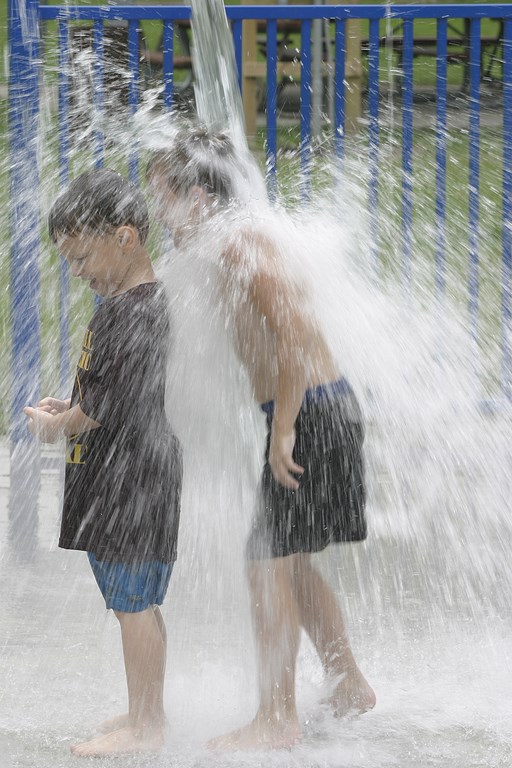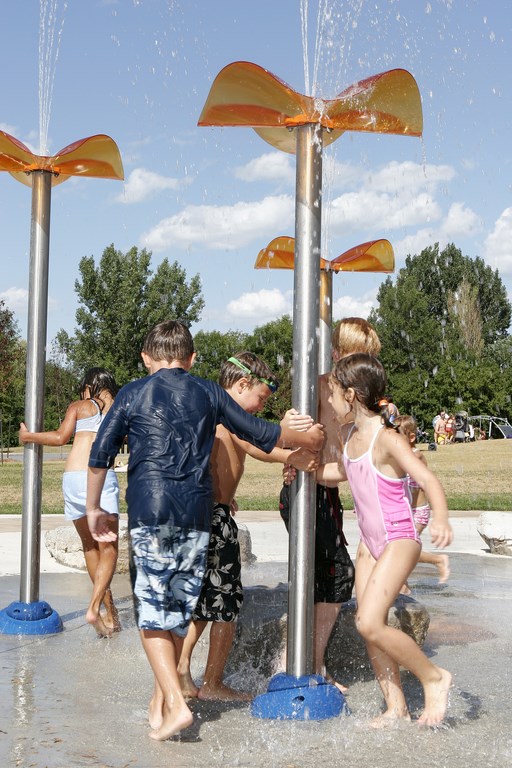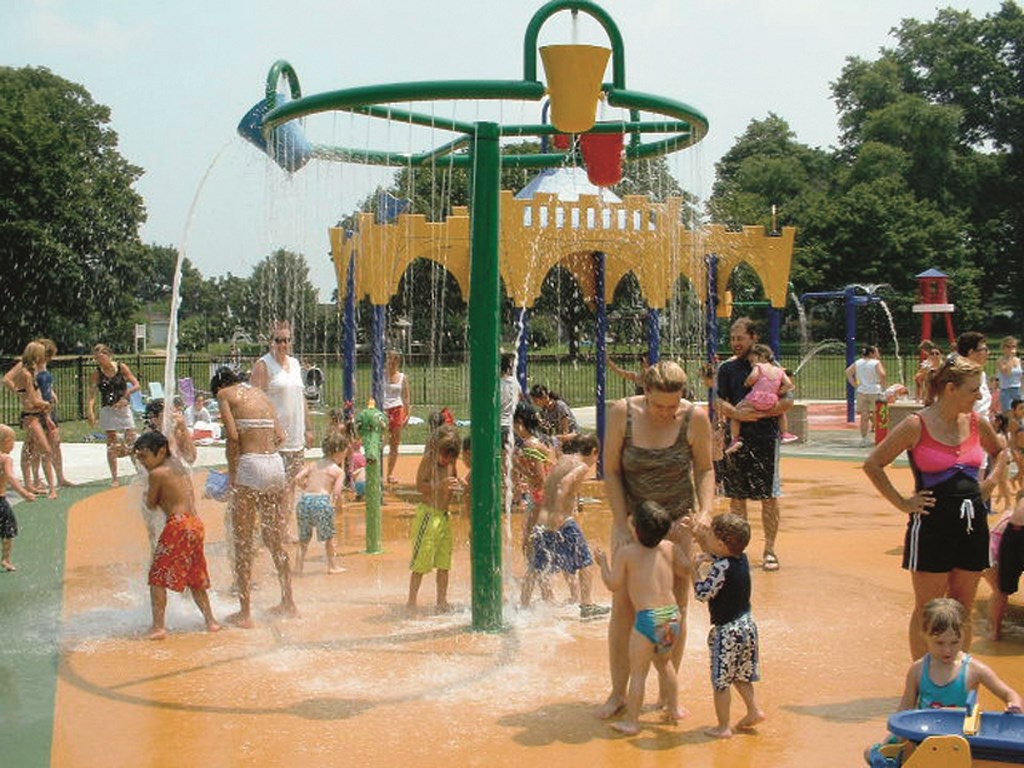Forms of Fun

Fifteen years ago, aquatic play attractions were found mainly in commercial waterparks in the form of large, multi-level, themed structures. Some smaller elements were found in the shallow ends of swimming pools, but they were generally limited to a few play apparatuses such as water umbrellas.
Much has changed in recent years, and aquatic play systems are now featured in a greater variety of settings including city parks, recreation centers, resorts and a range of other recreational spaces. This trend did not burst forth overnight: For more than ten years, our firm and others have been helping things along by focusing attention on the value of concepts related to zero-depth aquatic play.
We at Vortex Aquatic Structures in Montreal, for example, have designed our “Splashpads” to bring the joy and recreational value of aquatic play to almost any space. Among our objectives is bringing a measure of the commercial waterpark experience to places such as neighborhood parks, housing developments, campgrounds and other facilities, thereby allowing everyone within a community to experience aquatic play in safe environments.
FUN FUNCTIONS
Early on, our company focused on city parks and settings where playgrounds, basketball courts and sports fields provided primary recreational outlets for their communities. Our observation was that, with shrinking recreational budgets and outdated swimming pools, cities all over North America were looking for new ways of providing their citizens with aquatic recreation.
What was needed in many of these cases was a solution that involved small capital investment, low operating costs, safe fun with minimal supervision and, of course, a good aesthetic fit with existing environments.
That last point about aesthetics was particularly important: In the early days, the visual appeal of interactive water products was limited by the fact that their designs were greatly influenced by playground equipment. What this meant is that most first-generation aquatic play systems consisted of combinations of arches, spray posts, canes and other rectilinear shapes.
As time passed and the products continued to evolve, we at our company made a conscious decision to break that boxy mold and push interactive water in a new direction in which motion and the concept of living, organic features keyed our designs.
| The tendency among early interactive waterfeatures to follow the lead of fort-like playground equipment took its toll on design freedom, as can be seen in the pair of images of older-generation Splashpads at top. At the bottom, however, it’s easy to see the influence of the more organic forms being used today – and understand their growing popularity. |
We were challenged by this desire to create products that were visually appealing in ways that spoke to designers and clients. We also placed an emphasis on developing features that would provide fun and excitement while meeting the needs of children to develop physically, emotionally, socially and even educationally.
This is where, before long, we began seeing the intricacies involved in achieving a genuine balance between form and function.
We kept at it and did our homework, spending a great deal of time and effort in studying the behaviors of children in aquatic play settings. We watched them and cross-referenced our observations with child-development theory. Before long, we found patterns and began using what we’d seen to guide product design.
After studying several aquatic play areas, for example, we found that children under five years of age weren’t getting much attention. With all the excitement of spraying water cannons and big, dumping water buckets, toddlers were intimidated and often stayed on the periphery or in the arms of a their parents.
To be sure, there were play products designated for children in this youngest age group, but they were often positioned in areas right next to features that encouraged high-energy play and often attracted teenagers. Again, this caused the younger children to shy away.
DELIGHT BY DESIGN
As our research continued, we noticed other important factors – one of them centered on “time of play.” This is a term we used to describe the length of time or the level of frequency with which children interacted with play products.
This factor has particular importance because aquatic-play products are expected to have a life expectancy of more than 20 years. Every installation generates an immense amount of excitement for the community when it goes into service; what our observations of time of play told us was that, done right, aquatic play areas have an ongoing, positive effect on their environments that does not diminish with time.
In other words, we found that maximizing the various play opportunities that exist within well-developed product arrays can preserve that initial, peak level of excitement. A system filled with large spraying palm trees and water arches may meet aesthetic criteria, but it offers a limited range of play opportunities and will see a gradually diminishing time of play. In fact, we came to see these unsatisfying results as inevitable in cases where thought wasn’t given to maximizing time of play.
| In our approach, the water elements in ‘discovery bays’ are scaled to the play level of the youngest toddlers. These features introduce them to the joy of aquatic play in a non-intimidating environment that is isolated from the activities of bigger kids. |
Complicating the emergence of our philosophy of product design was the fact that there was a gap in regulations, standards and design guidelines for zero-depth aquatic play. That in mind, we leveraged the experience gained from thousands of Splashpad installations; solicited feedback from customers; observed and interviewed users; applied child-development theory; and consulted with designers to formulate a program that would assist customers and designers in their quest to design effective aquatic play areas.
This design philosophy is based on the recognition that any effective play area provides a variety of play opportunities for intended users. Our Splashpads are, for example, intended for users of all age groups and abilities. Although there are various types of play that require different levels of physical development and skills, water remains the common element.
Whether you’re considering a toddler playing in a puddle, a family running through the sprinklers on a hot afternoon or a group or teenagers waging a water fight with garden hoses, water is an endless source of play and fascination for kids. That in mind, we began categorizing forms of play, skills, learning and developmental issues into three defined “zones,” creating systems based on design principles that would create a balanced play environment and allow all users to experience the spirit of play offered by that environment.
IN THE ZONES
The first of these zones is what we call the “discovery bay,” which serves to introduce infants and toddlers to the interactive aquatic play environment. The bay features above-grade products that are scaled down to a level that’s not intimidating to the very young. In other words, there aren’t any buckets pouring torrents of water or similar large-scale features: Instead, there are compact features that might completely escape the attention of older children or adults (and perhaps even designers).
This approach emerged from our observation that small children have a significantly different level of attention to detail. They readily respond to vibrant colors, slight differences in water temperature or subtle variations of depth and flow. They are also captivated by the differences between a gentle misting spray compared to a gentle laminar flow or soft cascade – things we tend to overlook as adults.
This may seem simple – and in concept it is – but achieving these subtly distinctive effects and controlling water flows in these ways requires deliberate attention on the part of suppliers and designers and vision on the part of clients, which may be why these details are so often absent from interactive installations.
| Our ‘adventure bays’ constitute an intermediate ground in our three-level approach, offering a form of walk-through experience that enables everyone from confident older toddlers to playful adults to join in the fun. |
The next area is what we call the “adventure bay,” an area that encourages cross-generational play. An adult, for example, might pick up a small child and walk through a series of dumping buckets or a spraying arch or loop. This isn’t a high-energy play area, but instead encourages socializing in a casual walk-through, park-like experience. It is an area that encourages imagination through exciting and refreshing play.
This areas often serves as a natural centerpiece for a splash area, allowing for integration between the discovery bay and the high energy play environment featured in the third area, the “action bay,” which is where older kids experience high-energy activity – water fights, heavy flows of water and basically a good soaking.
One of the keys in this third bay is developing systems that encourage and require teamwork and friendly competition. We have a feature, for example, in which a flag rises as kids cooperate and cover ground sprays around its base, thus redirecting the water flow to the flag. In order to make the flag rise to its full height, a bunch of kids have to work together.
This multi-bay concept can be applied in play areas of all sizes, from waterparks to community aquatic centers. Regardless of project scope or scale, the three-level approach requires the supplier and the designer to consider systems from the child’s perspective – and that, we’ve observed, is the key to a successful system.
ELEVATING THE GAME
Interactive aquatic play areas almost always represent a significant investment, and it’s critical to suppliers, designers, installers and clients alike that the money be spent as wisely as possible. We believe that the three-bay approach – or other approaches that embrace the basic philosophy behind it – carries us a long way in the right direction by providing opportunities for kids of all ages and abilities.
We believe so because our research has shown us that by increasing the usefulness of splash areas across generational boundaries, we unlock a powerful means of enhancing the relationship that inherently exists between people of all ages and recreational water. And as this design sensitivity grows, interactive water systems will more easily be translated into an ever-broader range of settings.
This evolution, however, has created some very specific challenges:
[ ] First, in designing with access for everyone and multi-generational users in mind, suppliers must develop (and designers and clients must consider) smaller water elements. For settings such as housing developments where aquatic play areas are established as common ground for residents, developers want waterpark-level excitement but at a fraction of the budget.Again, understanding the needs of children enables watershapers to make cost-effective decisions in terms of the specific features chosen for a given composition.
[ ] Second, safety is a key issue for the entire play environment. When interactive aquatic play areas are installed outside waterparks or aquatic centers (where there are lifeguards and ready access to emergency services), there’s an increased need to ensure safety. This has led us to be more conservative with certain features. If we know there will be inconsistent supervision, for example, we’ll recommend systems that operate without any standing water. And we’ll also consult with the clients to ensure that the product choices suit the environment.| For bigger kids who delight in rowdier forms of play, the water cannons and high-flow sprays and deluges of our ‘action bays’ complete the three-level philosophy with which we approach interactive splash-area design. |
In addition to the safety of the structures we must also consider the safety of the water. With concern about waterborne pathogens on the rise, we must always ensure that the water is of pristine quality, which is one of the reasons our company now offers complete water-quality-management systems that not only control the distribution of water to the play features, but constantly monitor water quality as well.
This is critical: Splashpad water-quality management is, for example, very different from that of a pool. The system needs to be able to handle a much higher ratio of bathers to gallons of water, so where a typical pool might need water turnover every six hours, a Splashpad needs complete turnover every 30 minutes. Obviously, this requires specialized equipment and a formal, engineered approach.
[ ] Third, budget is a factor. Pragmatism is the key: There are situations in smaller systems where constraints will not permit development of all three bays. If that’s the case, we tend to focus our design efforts on features that fit the “adventure bay” model: This offers the most cross-generational play opportunities for all age groups. [ ] Fourth, aesthetics are an issue, as are the more refined tastes and expectations of designers and clients operating beyond the utilitarian waterpark realm. This leads us to develop facilities that look great while providing ample play opportunities. (More on aesthetic factors below.)THE COMMON FACTOR
Fortunately for all of us in the interactive-water business and regardless of the setting, children aren’t significantly different from place to place, so responses to the play elements we develop and install remain fairly consistent across a widening range of project types and locations.
The complexity comes with the need to determine ways of combining available elements in an overall composition that works in practical terms of dynamic entertainment while at the same time embodying an aesthetic approach that makes sense to clients, users and observers who see the facility on either a regular or occasional basis.
The physical configuration of the play elements can vary tremendously, and we’ve observed the greatest design challenges when it comes to support equipment – that is, the structures that give shape to the facility and serve as a framework for the interactive water systems.
Often, decisions in these aesthetic areas are driven by budget and space. Other times, regional or local codes also come into play, as in California, where particularly stringent standards for water quality in interactive water systems means accommodating the necessary filtration, pump and control systems. Handling these variables requires close coordination among suppliers, designers, installers and clients as well as regulators.
| Our research into the aquatic play habits of kids in multiple age groups showed us that it was possible to teach cooperation and socialization skills through structured water play – as in this case, where coordinated effort increases everyone’s fun. |
In other cases, challenges arise from the way interactive systems have traditionally been sold. Often clients approach suppliers directly, are given catalogs and are asked to make choices. This random, pull-it-off-the-shelf selection process – which often happens with designers as well – seldom leads to results that satisfy. In our experience, far better outcomes are achieved when there’s wall-to-wall communication among all key players in a given project:
With collaboration, we avoid the inadequate communications that can make projects more expensive and, yes, less visually appealing than they should be. We also avoid the problems that arise when the needs of end users – that is, children of a variety of ages and abilities – are not met. Finally, a more integrated approach stands a better chance of avoiding problems with health and building inspectors.
A good part of the burden for making this multi-layered developmental team coalesce around interactive water projects rests on the shoulders of suppliers. We need to inform watershapers, architects and landscape architects about the range of issues they face and what they should consider in designing these features. We need to do what we can to get involved (and stay involved) at the system-selection and design phases and pursue our mission through to installation and start-up.
Put another way, we need to become advocates for our whole category of products and do what we can to make certain they are used in ways that address the issues of form and function.
PERCEPTIVE SHIFT
The trends discussed here have been ongoing for approximately 15 years, and it’s no secret that much of the original demand for interactive water was generated by waterparks. As more and more consumers have had positive experiences in these settings, more and more have sought to replicate their experiences in other places.
| The greatest success an aquatic recreation facility can have comes when multiple generations, from the very young through to parent and grandparents, all find ways to have fun in the water together. |
For many years, that process was all about transplanting those same features to a different type of property. That has changed, however, and we’re running into an increasing number of designers who embrace the fact that interactive aquatic play is about more than excitement and also includes a strong aesthetic component.
This evolution in thinking is a driving factor in today’s marketplace, with many of the newer systems bearing little resemblance to the grand-scale fort approach that dominated product design and development in years past. It’s all still fun, but it is gaining in sophistication with almost every new project.
In reaching for sophistication, of course, we must never lose track of the fun and excitement these installations bring to children in all age groups and at all socio-economic levels. Our products have the ability to be waterpark by day and sculpture by night.
For me, however, there’s just nothing better than seeing the joy in a child’s face as he or she plays on one of our Splashpads. Ultimately, such results speak for themselves.
Stephen Hamelin is founder and president of Vortex Aquatic Structures International in Montreal, where he plays a key role in day-to-day operations while providing the company with its forward-looking vision. Since he started this design/product development/deployment company in 1995, Vortex has installed more than 2,000 systems and has built a reputation for quality, attention to detail and innovative, unique designs in zero-depth aquatic play environments.






















